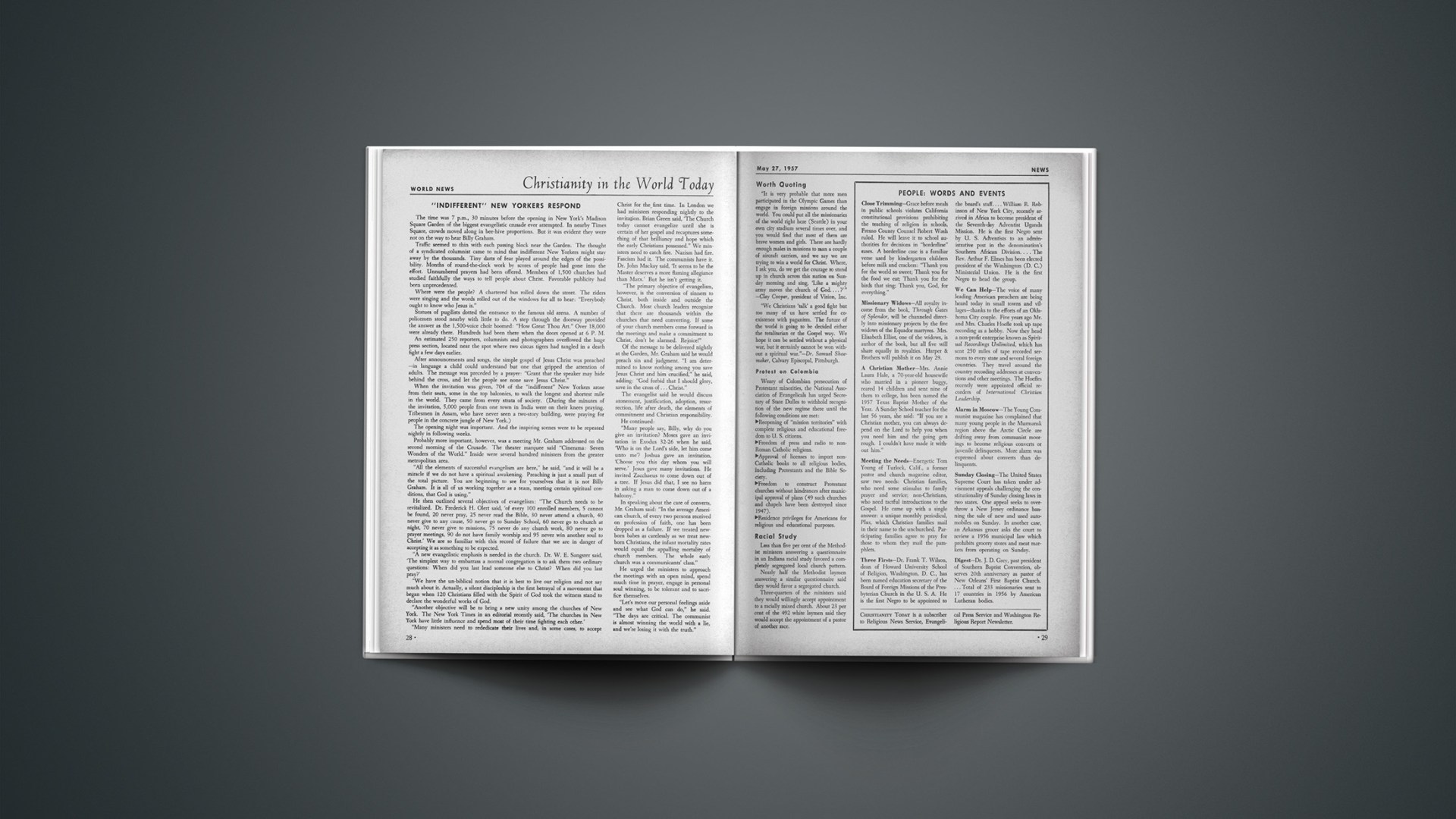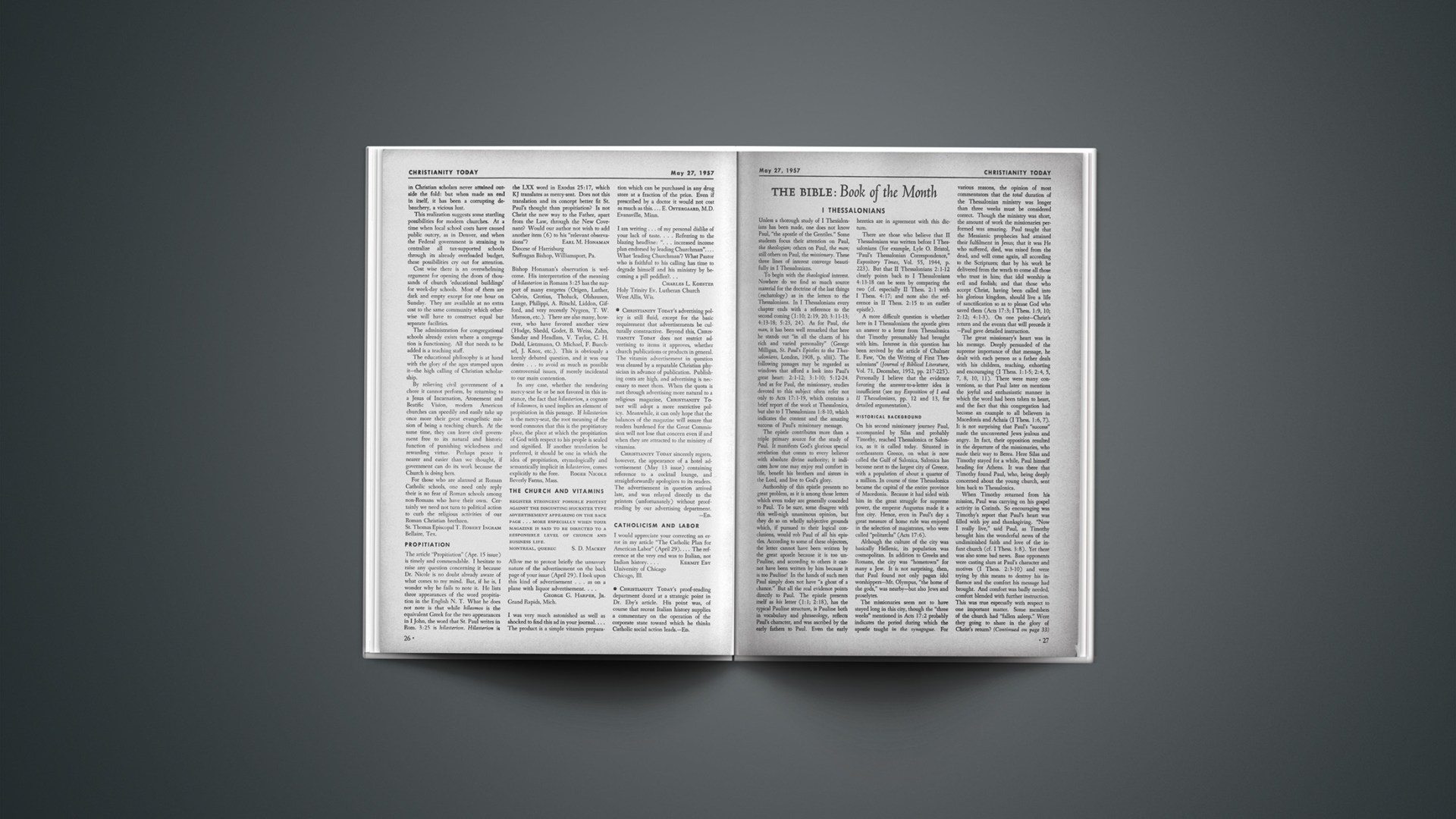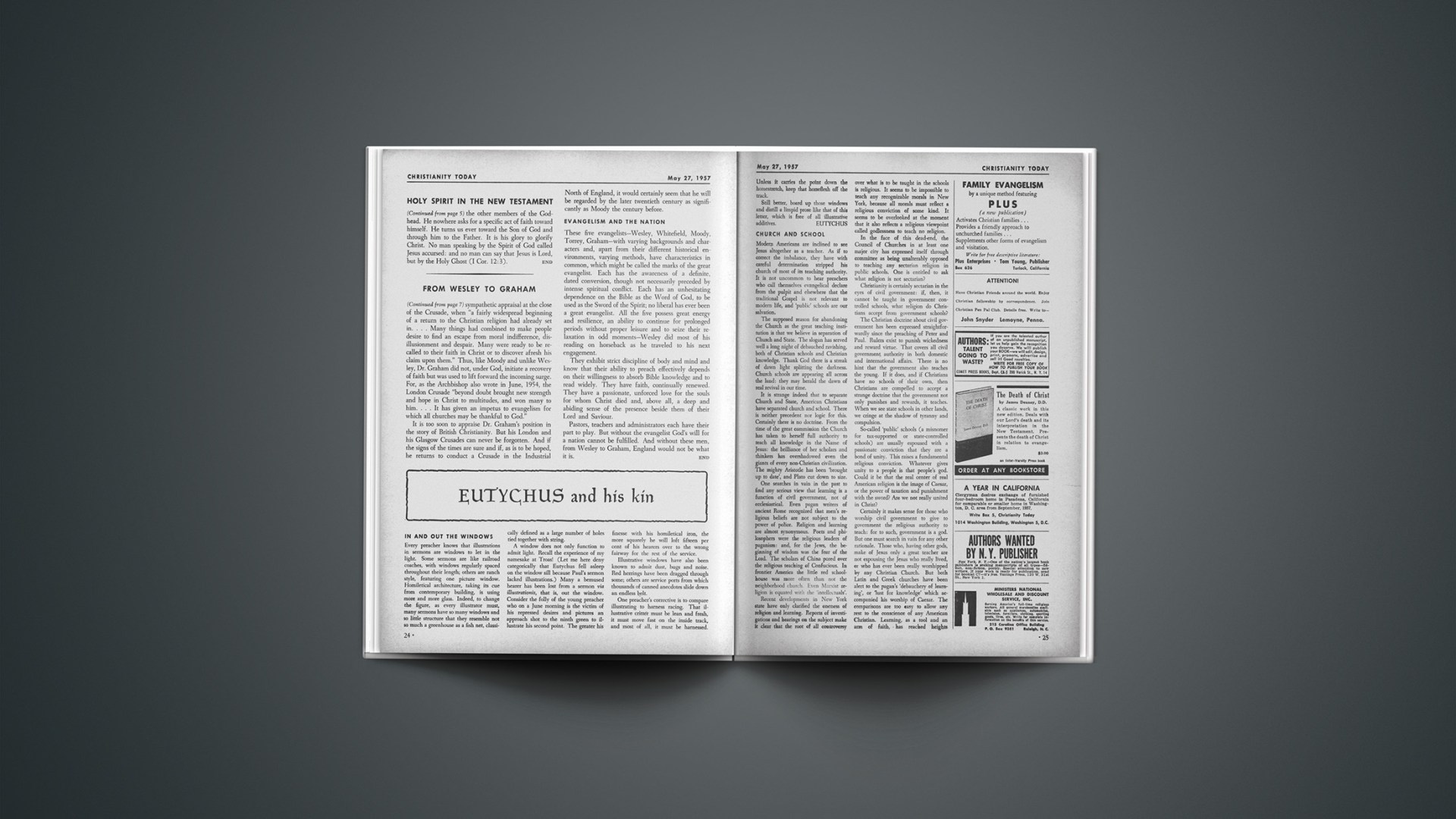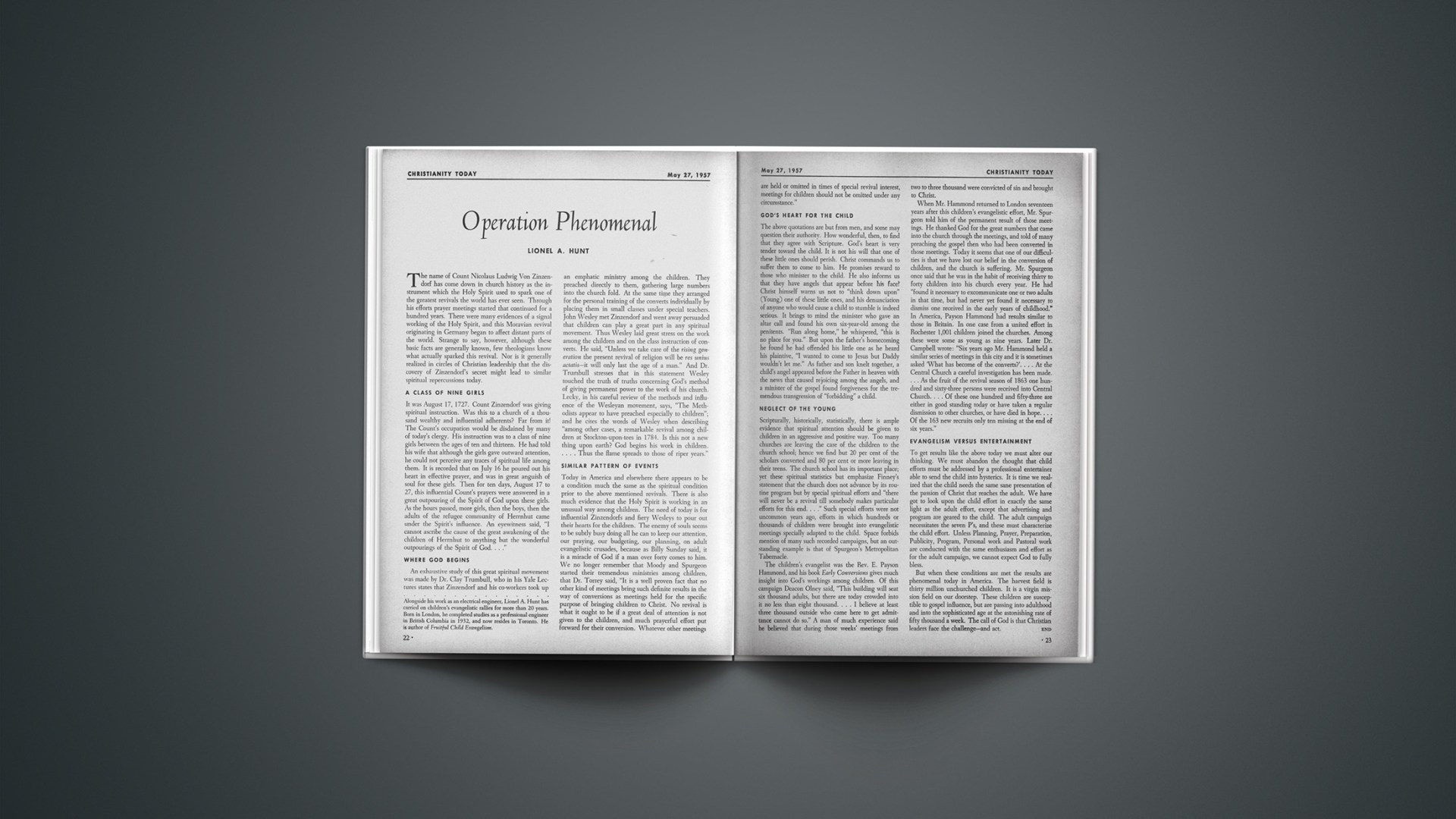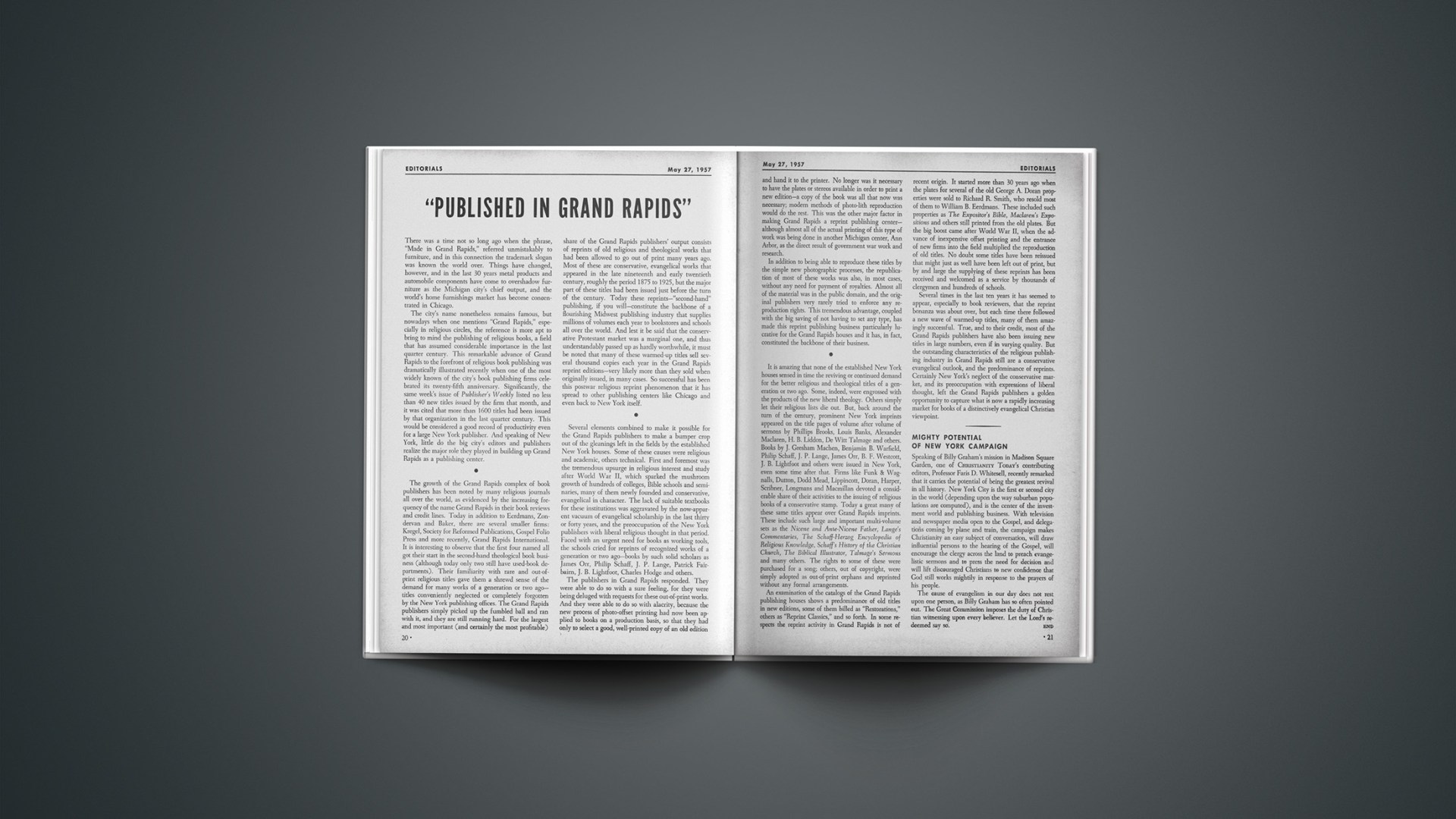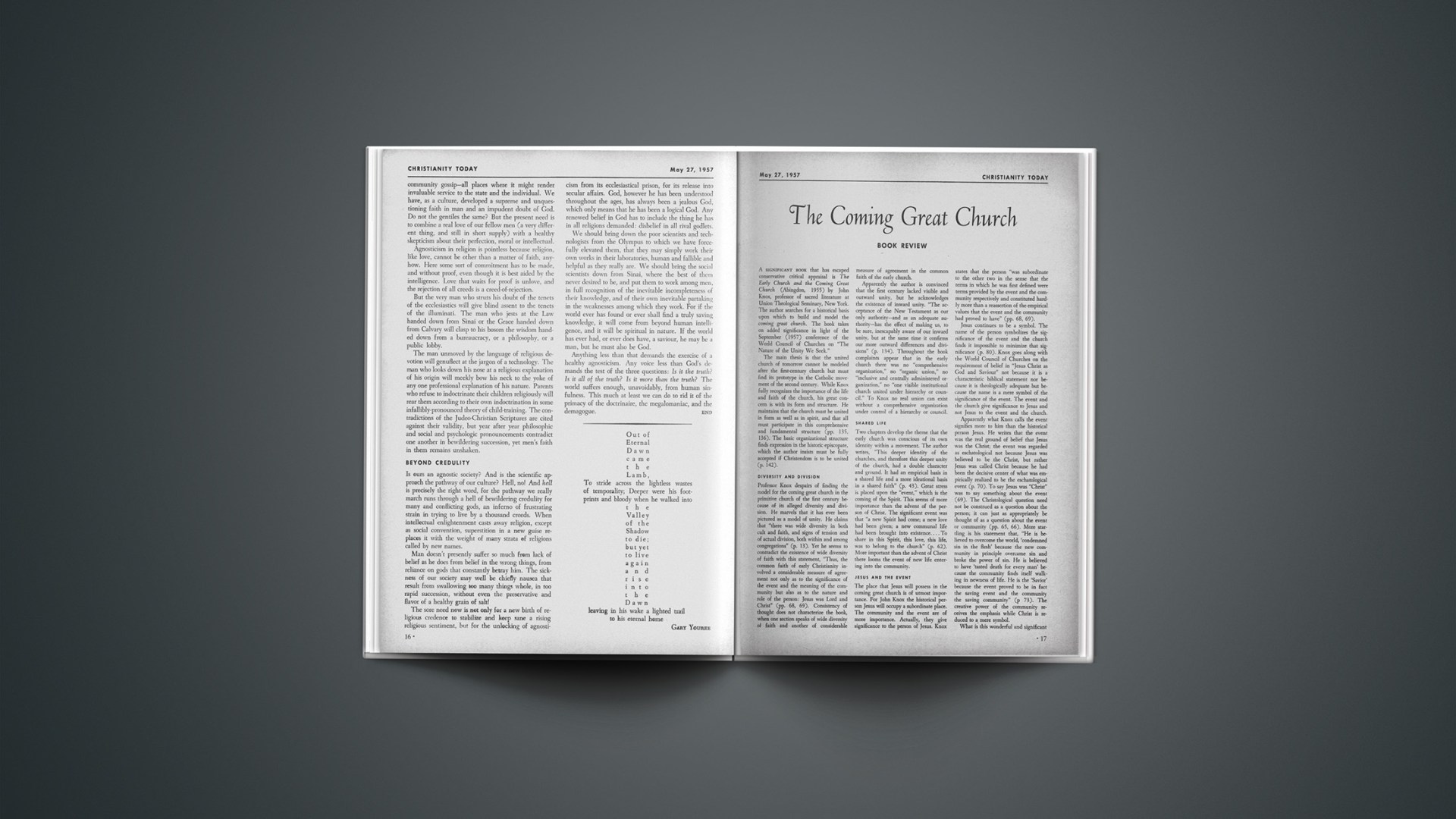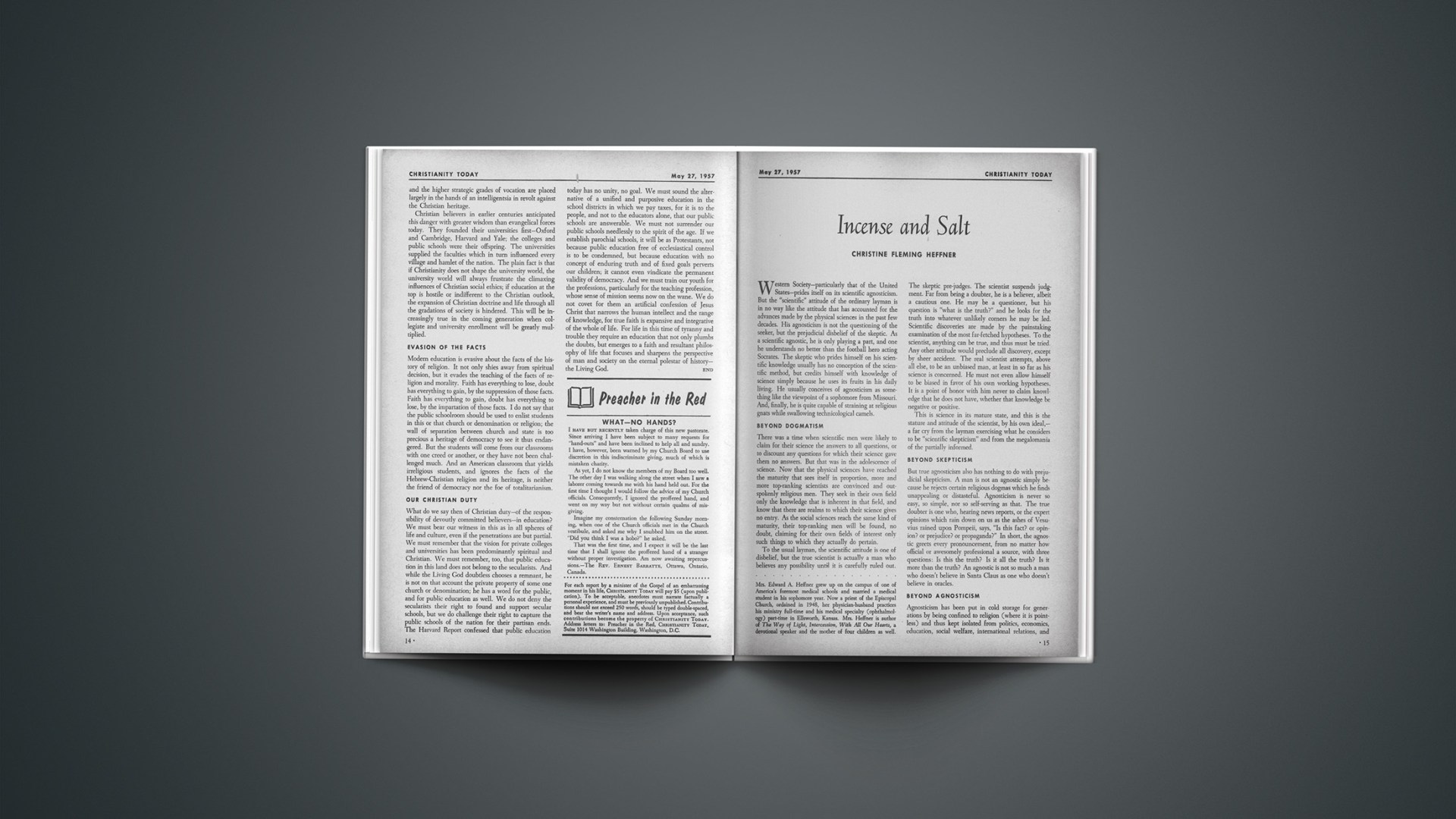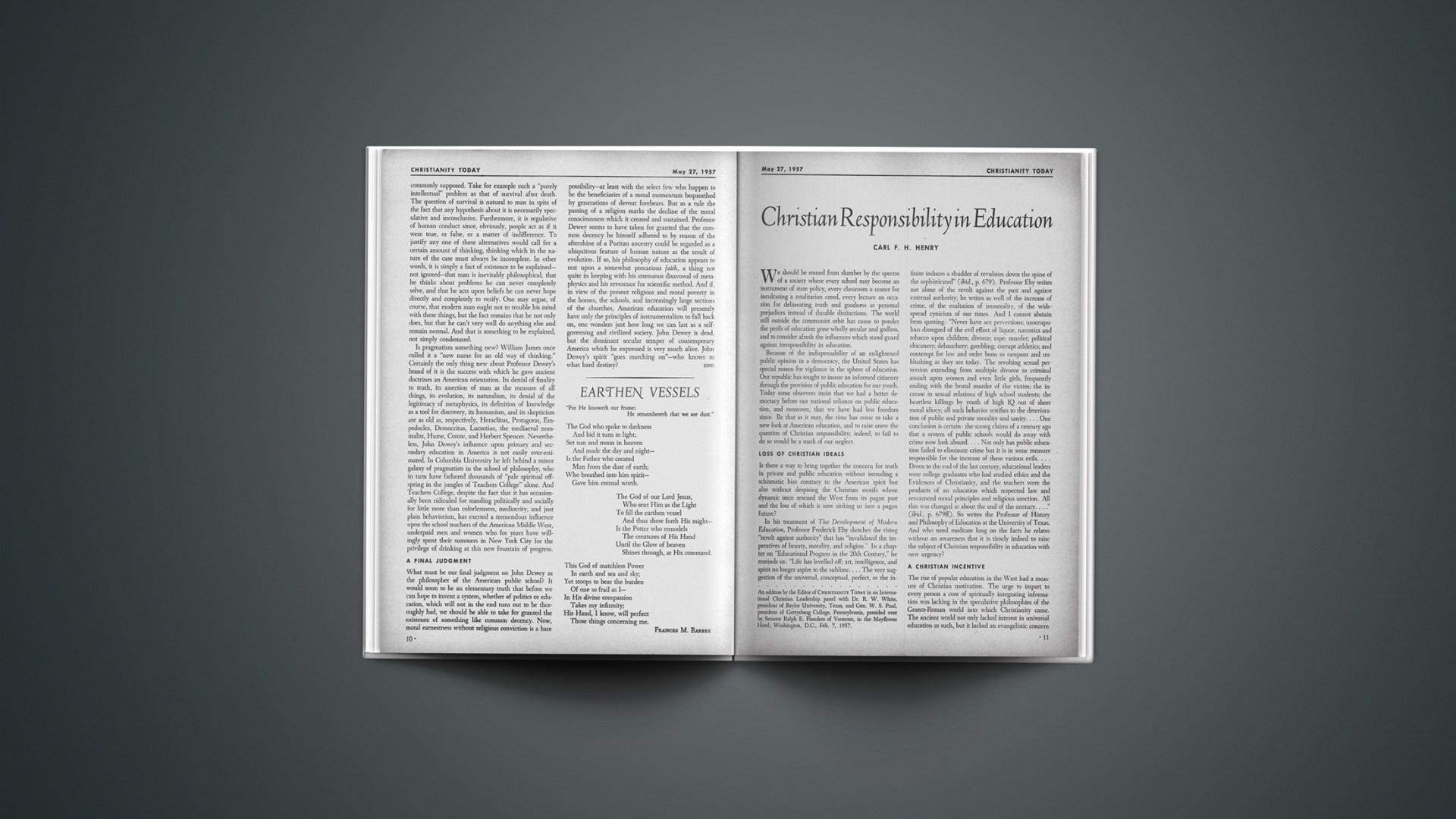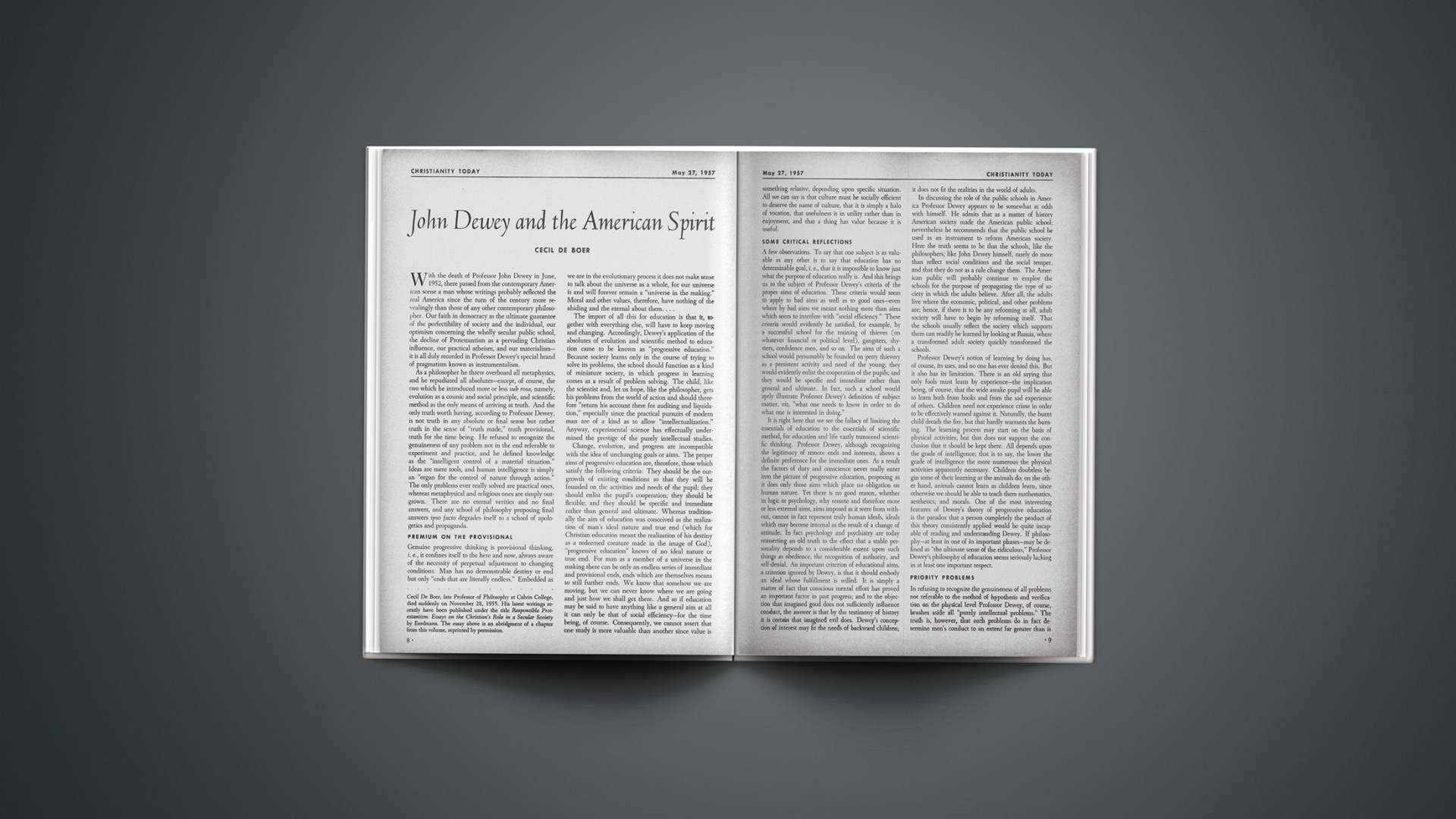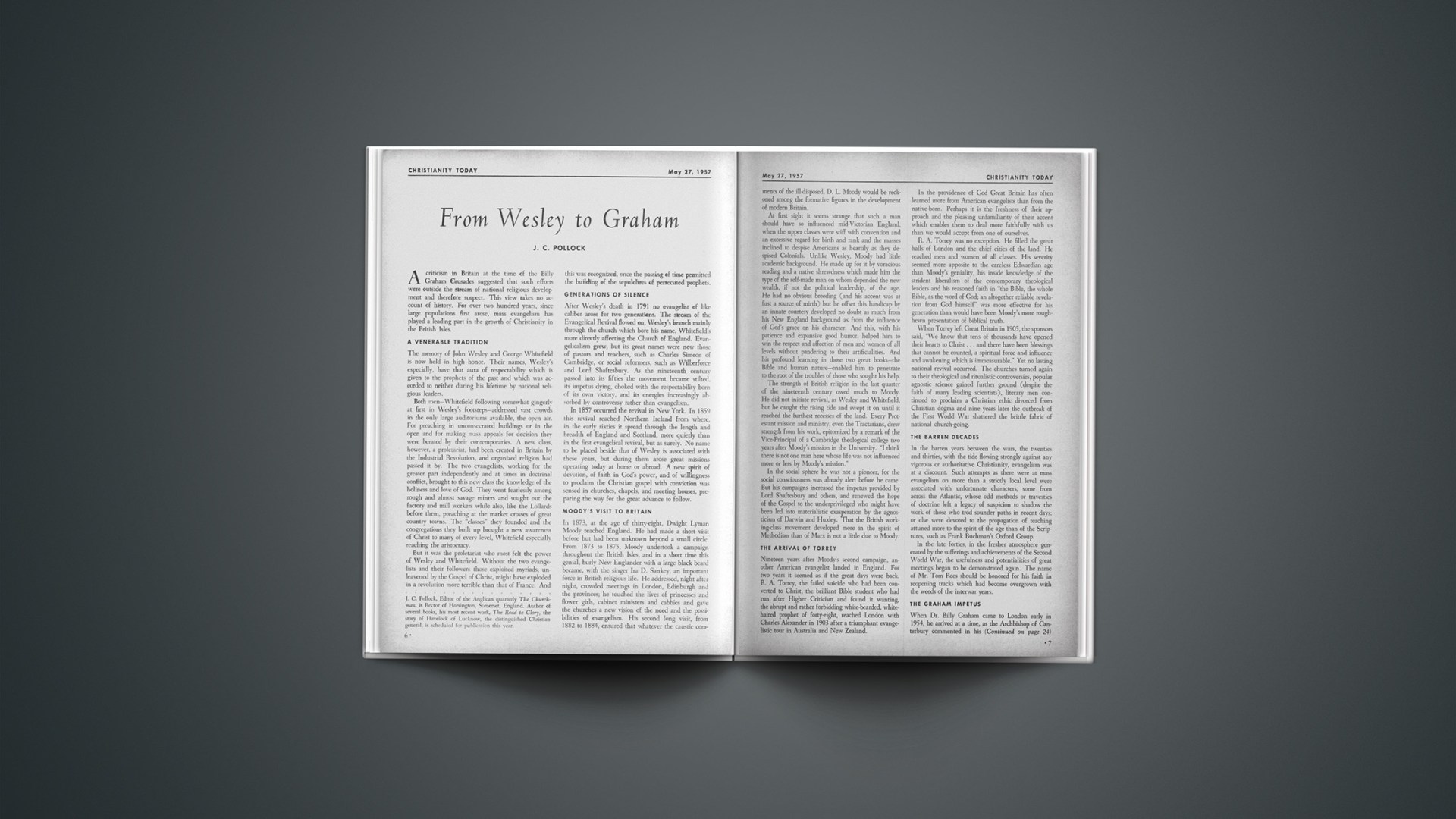WORLD NEWS
Christianity in the World Today
The time was 7 p.m., 30 minutes before the opening in New York’s Madison Square Garden of the biggest evangelistic crusade ever attempted. In nearby Times Square, crowds moved along in bee-hive proportions. But it was evident they were not on the way to hear Billy Graham.
Traffic seemed to thin with each passing block near the Garden. The thought of a syndicated columnist came to mind that indifferent New Yorkers might stay away by the thousands. Tiny darts of fear played around the edges of the possibility. Months of round-the-clock work by scores of people had gone into the effort. Unnumbered prayers had been offered. Members of 1,500 churches had studied faithfully the ways to tell people about Christ. Favorable publicity had been unprecedented.
Where were the people? A chartered bus rolled down the street. The riders were singing and the words rolled out of the windows for all to hear: “Everybody ought to know who Jesus is.”
Statues of pugilists dotted the entrance to the famous old arena. A number of policemen stood nearby with little to do. A step through the doorway provided the answer as the 1,500-voice choir boomed: “How Great Thou Art.” Over 18,000 were already there. Hundreds had been there when the doors opened at 6 P. M.
An estimated 250 reporters, columnists and photographers overflowed the huge press section, located near the spot where two circus tigers had tangled in a death fight a few days earlier.
After announcements and songs, the simple gospel of Jesus Christ was preached—in language a child could understand but one that gripped the attention of adults. The message was preceded by a prayer: “Grant that the speaker may hide behind the cross, and let the people see none save Jesus Christ.”
When the invitation was given, 704 of the “indifferent” New Yorkers arose from their seats, some in the top balconies, to walk the longest and shortest mile in the world. They came from every strata of society. (During the minutes of the invitation, 5,000 people from one town in India were on their knees praying. Tribesmen in Assam, who have never seen a two-story building, were praying for people in the concrete jungle of New York.)
The opening night was important. And the inspiring scenes were to be repeated nightly in following weeks.
Probably more important, however, was a meeting Mr. Graham addressed on the second morning of the Crusade. The theater marquee said “Cinerama: Seven Wonders of the World.” Inside were several hundred ministers from the greater metropolitan area.
“All the elements of successful evangelism are here,” he said, “and it will be a miracle if we do not have a spiritual awakening. Preaching is just a small part of the total picture. You are beginning to see for yourselves that it is not Billy Graham. It is all of us working together as a team, meeting certain spiritual conditions, that God is using.”
He then outlined several objectives of evangelism: “The Church needs to be revitalized. Dr. Frederick H. Olert said, ‘of every 100 enrolled members, 5 cannot be found, 20 never pray, 25 never read the Bible, 30 never attend a church, 40 never give to any cause, 50 never go to Sunday School, 60 never go to church at night, 70 never give to missions, 75 never do any church work, 80 never go to prayer meetings, 90 do not have family worship and 95 never win another soul to Christ.’ We are so familiar with this record of failure that we are in danger of accepting it as something to be expected.
“A new evangelistic emphasis is needed in the church. Dr. W. E. Sangster said, ‘The simplest way to embarrass a normal congregation is to ask them two ordinary questions: When did you last lead someone else to Christ? When did you last pray?’
“We have the un-biblical notion that it is best to live our religion and not say much about it. Actually, a silent discipleship is the first betrayal of a movement that began when 120 Christians filled with the Spirit of God took the witness stand to declare the wonderful works of God.
“Another objective will be to bring a new unity among the churches of New York. The New York Times in an editorial recently said, ‘The churches in New York have little influence and spend most of their time fighting each other.’
“Many ministers need to rededicate their lives and, in some cases, to accept Christ for the first time. In London we had ministers responding nightly to the invitation. Brian Green said, ‘The Church today cannot evangelize until she is certain of her gospel and recaptures something of that brilliancy and hope which the early Christians possessed.” We ministers need to catch fire. Nazism had fire. Fascism had it. The communists have it. Dr. John Mackay said, ‘It seems to be the Master deserves a more flaming allegiance than Marx.’ But he isn’t getting it.
“The primary objective of evangelism, however, is the conversion of sinners to Christ, both inside and outside the Church. Most church leaders recognize that there are thousands within the churches that need converting. If some of your church members come forward in the meetings and make a commitment to Christ, don’t be alarmed. Rejoice!”
Of the message to be delivered nightly at the Garden, Mr. Graham said he would preach sin and judgment. “I am determined to know nothing among you save Jesus Christ and him crucified,” he said, adding: “God forbid that I should glory, save in the cross of … Christ.”
The evangelist said he would discuss atonement, justification, adoption, resurrection, life after death, the elements of commitment and Christian responsibility.
He continued:
“Many people say, Billy, why do you give an invitation? Moses gave an invitation in Exodus 32–36 when he said, ‘Who is on the Lord’s side, let him come unto me’? Joshua gave an invitation, ‘Choose you this day whom you will serve.’ Jesus gave many invitations. He invited Zacchaeus to come down out of a tree. If Jesus did that, I see no harm in asking a man to come down out of a balcony.”
In speaking about the care of converts, Mr. Graham said: “In the average American church, of every two persons received on profession of faith, one has been dropped as a failure. If we treated newborn babes as carelessly as we treat newborn Christians, the infant mortality rates would equal the appalling mortality of church members. The whole early church was a communicants’ class.”
He urged the ministers to approach the meetings with an open mind, spend much time in prayer, engage in personal soul winning, to be tolerant and to sacrifice themselves.
“Let’s move our personal feelings aside and see what God can do,” he said. “The days are critical. The communist is almost winning the world with a lie, and we’re losing it with the truth.”
Worth Quoting
“It is very probable that more men participated in the Olympic Games than engage in foreign missions around the world. You could put all the missionaries of the world right here (Seattle) in your own city stadium several times over, and you would find that most of them are brave women and girls. There are hardly enough males in missions to man a couple of aircraft carriers, and we say we are trying to win a world for Christ. Where, I ask you, do we get the courage to stand up in church across this nation on Sunday morning and sing, ‘Like a mighty army moves the church of God.…?’ ”—Clay Cooper, president of Vision, Inc.
“We Christians ‘talk’ a good fight but too many of us have settled for coexistence with paganism. The future of the world is going to be decided either the totalitarian or the Gospel way. We hope it can be settled without a physical war, but it certainly cannot be won without a spiritual war.”—Dr. Samuel Shoemaker, Calvary Episcopal, Pittsburgh.
Protest On Colombia
Weary of Colombian persecution of Protestant minorities, the National Association of Evangelicals has urged Secretary of State Dulles to withhold recognition of the new regime there until the following conditions are met:
► Reopening of “mission territories” with complete religious and educational freedom to U. S. citizens.
► Freedom of press and radio to non-Roman Catholic religions.
► Approval of licenses to import non-Catholic books to all religious bodies, including Protestants and the Bible Society.
► Freedom to construct Protestant churches without hindrances after municipal approval of plans (49 such churches and chapels have been destroyed since 1947).
► Residence privileges for Americans for religious and educational purposes.
Racial Study
Less than five per cent of the Methodist ministers answering a questionnaire in an Indiana racial study favored a completely segregated local church pattern.
Nearly half the Methodist laymen answering a similar questionnaire said they would favor a segregated church.
Three-quarters of the ministers said they would willingly accept appointment to a racially mixed church. About 23 per cent of the 492 white laymen said they would accept the appointment of a pastor of another race.
People: Words And Events
Close Trimming—Grace before meals in public schools violates California constitutional provisions prohibiting the teaching of religion in schools, Fresno County Counsel Robert Wash ruled. He will leave it to school authorities for decisions in “borderline” eases. A borderline case is a familiar verse used by kindergarten children before milk and crackers: “Thank you for the world so sweet; Thank you for the food we eat; Thank you for the birds that sing; Thank you, God, for everything.”
Missionary Widows—All royalty income from the book, Through Gates of Splendor, will be channeled directly into missionary projects by the five widows of the Equador martyres. Mrs. Elisabeth Elliot, one of the widows, is author of the book, but all five will share equally in royalties. Harper & Brothers will publish it on May 29.
A Christian Mother—Mrs. Annie Laura Hale, a 70-year-old housewife who married in a pioneer buggy, reared 14 children and sent nine of them to college, has been named the 1957 Texas Baptist Mother of the Year. A Sunday School teacher for the last 56 years, she said: “If you are a Christian mother, you can always depend on the Lord to help you when you need him and the going gets rough. I couldn’t have made it without him.”
Meeting the Needs—Energetic Tom Young of Turlock, Calif., a former pastor and church magazine editor, saw two needs: Christian families, who need some stimulus to family prayer and service; non-Christians, who need tactful introductions to the Gospel. He came up with a single answer: a unique monthly periodical, Plus, which Christian families mail in their name to the unchurched. Participating families agree to pray for those to whom they mail the pamphlets.
Three Firsts—Dr. Frank T. Wilson, dean of Howard University School of Religion, Washington, D. C., has been named education secretary of the Board of Foreign Missions of the Presbyterian Church in the U. S. A. He is the first Negro to be appointed to the board’s staff.… William R. Robinson of New York City, recently arrived in Africa to become president of the Seventh-day Adventist Uganda Mission. He is the first Negro sent by U. S. Adventists to an administrative post in the denomination’s Southern African Division.… The Rev. Arthur F. Elmes has been elected president of the Washington (D. C.) Ministerial Union. He is the first Negro to head the group.
We Can Help—The voice of many leading American preachers are being heard today in small towns and villages—thanks to the efforts of an Oklahoma City couple. Five years ago Mr. and Mrs. Charles Hoefle took up tape recording as a hobby. Now they head a non-profit enterprise known as Spiritual Recordings Unlimited, which has sent 250 miles of tape recorded sermons to every state and several foreign countries. They travel around the country recording addresses at conventions and other meetings. The Hoefles recently were appointed official recorders of International Christian Leadership.
Alarm in Moscow—The Young Communist magazine has complained that many young people in the Murmansk region above the Arctic Circle are drifting away from communist moorings to become religious converts or juvenile delinquents. More alarm was expressed about converts than delinquents.
Sunday Closing—The United States Supreme Court has taken under advisement appeals challenging the constitutionality of Sunday closing laws in two states. One appeal seeks to overthrow a New Jersey ordinance banning the sale of new and used automobiles on Sunday. In another case, an Arkansas grocer asks the court to review a 1956 municipal law which prohibits grocery stores and meat markets from operating on Sunday.
Digest—Dr. J. D. Grey, past president of Southern Baptist Convention, observes 20th anniversary as pastor of New Orleans’ First Baptist Church.… Total of 233 missionaries sent to 17 countries in 1956 by American Lutheran bodies.
A Man Of God
Hundreds of pastors assembled in Chicago for a conference before the 100th annual session of the Southern Baptist Convention, May 29–June 1.
One of the challenging messages they heard was particularly timely, after a lot of recent national publicity about ministers suffering nervous breakdowns. The talk was given by Dr. F. Townley Lord of London, former president of the Baptist World Alliance.
His address follows, in part:
“The description of the Christian pastor as a ‘man of God’ is uplifting, heartwarming, challenging … and sometimes humiliating; for there can be few of us who do not realize how far short we fall of that great ideal. Once in my vestry in central London an actress came to discuss some personal problems. To my question, ‘Why have you come to me?’ she replied, ‘But aren’t you a man of God?’
“It is good to be reminded of the dignity and solemn responsibility of our high calling. Emerson told some divinity students that the minister’s function is ‘to acquaint men at first-hand with deity.’ George Herbert, once public orator in the University of Cambridge, defined a pastor as ‘the deputy of Christ for the reducing of men to the obedience of God.’
“These are great ideals; yet when I want to learn what it means to be a man of God, I turn to the Bible, for it is the Word of God that gives us a great procession of men of God, spotlighting their call, adventures, trials, successes, failures. In this biblical portrait gallery, one thing stands out with crystal clarity: its men of God were subjected to strain and pressure, generally from without, sometimes from within. The way of obedience to God was not for them the ‘primrose path of dalliance.…’
“You will not fail to observe that the strains and stresses felt by the Bible’s men of God were not unlike those we know and experience today.… How modern it all sounds! Working on unresponsive material, setting one’s course against popular demands, fitting a message of divine love and grace to a world embroiled in rivalries and war, battling against disappointment and frustration, keeping a brave face when tragedy gnaws at the heart.
“There is one figure in the Bible who seems to have combined in his own experience most of the discouragements men can conceive—Paul, apostle to the Gentiles. I mention him not just to add to the list of the Bible heroes, but because I think he had found the secret of keeping calm under pressure. He had critics by the score. They made fun of his appearance. They questioned his standing and authority. Sometimes he gives us an autobiographical passage, as when he writes (2 Cor. 11:26–28) of being:
‘In perils in the city, in perils in the wilderness, in perils in the sea, in perils among false brethren; in weariness and painfulness, in watchings often, in hunger and thirst, in fastings often, in cold and nakedness; beside those things that are without, that which cometh upon me daily, the care of all the churches.’
“Yet, in the same letter from which this quotation is taken, he can say twice in one chapter, ‘I never lose heart.’
“That is the secret we want to know. Never to lose heart. Never to allow disappointment to cast a shadow of doubt on the great cause. Never to permit indignation to warp our judgment. Never to allow anything to obscure the one supreme fact that we are God’s men, representing him to the world.
“Paul gives us his own secret (2 Cor. 4:16–18):
‘But though our outward man perish, yet the inward man is renewed day by day. For our light affliction, which is but for a moment, worketh for us a far more exceeding and eternal weight of glory; while we look not at the things which are seen, but at the things which are not seen; for the things which are seen are temporal, but the things which are not seen are eternal.’
“His secret is two fold. Part of it is paradoxical. The man of God looks at something he can’t see. He keeps his vision of timeless realities. The other part is inward—the renewal of inner life day by day. I have never known a Christian pastor who put this recipe to the test without finding that it is the door to serenity and patience in ministry.
“To keep our eyes turned towards the unseen, to know so much of the daily presence of the Lord Jesus in the heart—this is to discover the power of calmness under pressure.”
Literary Needs
“More trained personnel and greater emphasis on distribution are the most pressing needs in missionary literature work,” Kenneth N. Taylor, director of Moody Institute’s Literature Mission, said recently after completing a tour of Christian centers in the Near and Far East. He added:
“The products of missionary publishers will have to be improved to meet the competition of western magazines penetrating the Far East. To be effective, Christian literature must be printed on good paper, with attractive art, layout and color. Communists have been making remarkable inroads with attractive literature at very low prices.…”
Parochial Funds
“Unalterable opposition” to the use of public funds for the support of independent or parochial schools was voiced in a special committee report at the 169th General Assembly of the Presbyterian Church in the U. S. A. (Northern) at Omaha, Nebraska, May 16–22.
In opposing public support of parochial schools, the report denied that these institutions are part of “community education.”
“Parochial schools, avowedly sectarian,” the report said, “are not amenable to the control of the community from which they seek support. There is a widespread and aggressive movement that asserts that the parochial school is really a part of public education. This contention confuses the public and is contrary to the fact that parochial schools and public schools are created upon entirely different foundations.”
The committee said that “confusion in the public mind can result in withdrawal of support from the public schools.”
The report also condemned “the practice of virtual donations of public school buildings, under the guise of sales, to parochial school systems below legitimately assessed evaluation regardless of lack of public school population or majority registration in parochial schools.”
Some 880 commissioners, lay and clerical, representing the denomination’s 250 presbyteries, attended the Omaha convention.
Rc School View
Archbishop William O. Brady of St. Paul, Minn., has spelled out the conditions under which Roman Catholics may attend or participate in public school baccalaureate ceremonies.
Priests may not participate nor Catholics attend if the rites are held in non-Catholic churches. And it is not permissable to hold public school graduations and baccalaureates in Catholic churches.
If the baccalaureate observances are held in a public place, there is no reason why Catholic clergy should not appear and speak, the archbishop said.
He traced the origin of baccalaureate observances to universities in Europe where “practically all education was religious and Catholic.… It is interestingly strange that now, when public education is more or less officially denuded of religion, how popular baccalaureate sermons remain.… Where baccalaureate day is no longer a religious occasion, but really a social event, it may be accepted and shared by all, even if it has no current meaning. But a difficulty will always appear in our pluralistic society as soon as our public schools attempt to crown the final days of the secular academic year with a religious sugar coating.…”
Christian Unity
Observers predict that the Third Assembly of the Lutheran World Federation in Minneapolis, Minn., August 15–25, will be one of the most significant religious meetings held on American soil in decades.
The Federation represents an estimated 50 million Lutherans from 29 countries.
Dr. Carl E. Lund-Quist, executive secretary of the LWF, said the Assembly hoped to make a major contribution to theological discussion on the question of Christian unity.
He said the question of unity will be considered with regard to the relation of the Lutheran churches to each other as well as to the possibility of church fellowship between Lutherans and others, particularly those in the World Council of Churches.
Dr. Hanns Lilje, Bishop of Hannover, Germany, Federation president, will preside at all formal sessions and will present the keynote address. Speakers on the program include Dr. Rajah B. Manikam, Bishop of Tranquebar, India; Dr. Otto Dibelius, Bishop of the Church of Berlin-Brandenburg and president of the Evangelical Church in Germany and Dr. Lajos Ordass, Bishop of the Lutheran Church in Hungary.
Redpath On Trip
The Rev. Alan Redpath, pastor of Moody Church, Chicago, will be away from his pulpit until August 29.
He will be a principal speaker at both the Irish and English Keswick. Also, he will visit in Austria before returning.
Mr. Redpath is chairman of the Mid-America Keswick to be held in Chicago October 12–19.
Fcc Rejects Protest
The Federal Communications Commission has rejected a protect by Dr. J. Richard Sneed, First Methodist Church, Los Angeles, against the action of Radio Station KFAC in dropping the church’s 34-year-old religious broadcast.
The Commission said it had been informed by KFAC that the station was consulting with the Church Federation of Los Angeles to find a different religious program to replace the Methodist service.
Accordingly, the FCC said it found no grounds for ordering a public hearing.
Dr. Sneed said he had been told by the station that “we are gradually eliminating all religious programs and replacing them with musical programs.”
(A number of churches have received broadcast termination notices since the Broadcasting and Film Commission of the National Council of Churches adopted an advisory policy against the sale of time for religious programs, but practically all such churches were members of denominations not affiliated with the Council—(CHRISTIANITY TODAY, April 1, issue). First Methodist in Los Angeles is affiliated with the NCC.
In a five-page letter to the Los Angeles clergymen, the FCC cited provisions of the Federal Communications Act and decisions of the Federal courts which limit its power to control the specific programming of a radio station. (Radio and television stations, in applying to the Commission for licenses, state the percentage of time that will be devoted to religious programs. KFAC, in its application for a three-year license renewal in 1956, informed the FCC that 1.9 per cent of its broadcast time was devoted to religious services.)
Meanwhile, in another broadcast development, Radio Station WGY in Schenectady, N. Y., said it was dropping paid religious broadcasts because it had an “imbalance of fundamentalist Protestant theology” in its religious programming. The station is owned by the General Electric Company.
The station said it would continue to provide free time for an “adequate, representative schedule of religious broadcasts.” Merl Galusha, WGY manager, said the station had declined to renew a contract for Billy Graham’s “Hour of Decision.”
Other programs that will no longer be carried on a paid basis after present contracts expire, he said, are “Word of Life,” “Bible Study Hour,” “The Lutheran Hour” and “Voice of Prophecy.”
It is “quite likely,” according to the manager, that some programs previously carried on a paid basis will be included in the free-time schedule.

